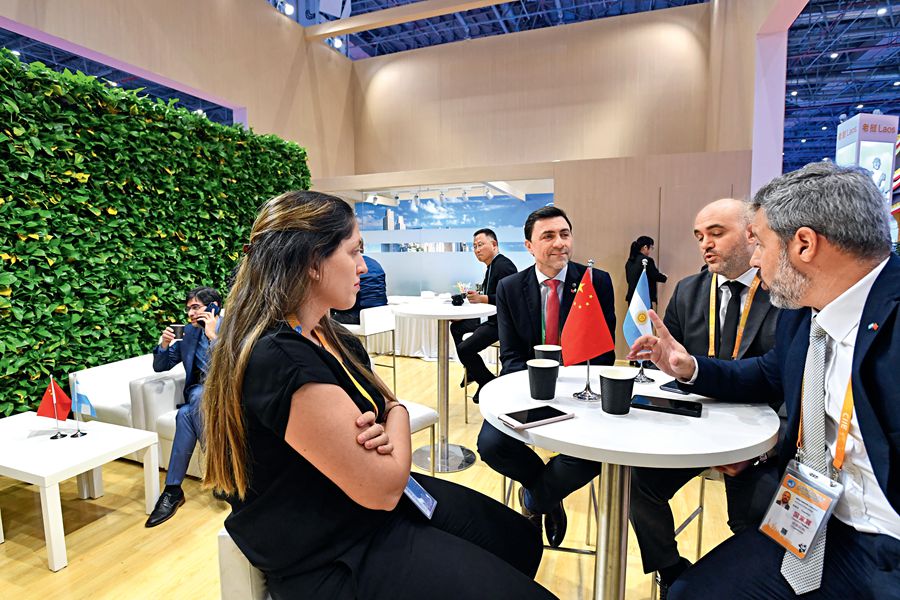<span style=""font-family:">The Road Continues South:China’s Expansion of the Belt and Road Investment in Latin America</span>SIX years after Chinese President Xi Jinping proposed the Belt and Road Initiative (BRI), it remains the world’s most ambitious investment plan. The opportunities that the BRI offers in facilitating prosperity through developing trade links and creating jobs are unparalleled. However, for the BRI to achieve its boldest aspirations, participating countries in Latin America, including Uruguay, must also work domestically and with China to adopt complementary policies that promote long-term, responsible, and sustainable economic growth.

China has become Argentina’s second largest trade partner as bilateral cooperation expands and deepens to unprecedented levels.
The BRI is a trillion-dollar global economic framework that connects China and more than 100 partner countries with one third of the global GDP and nearly two-thirds of the world’s population. There are five broad objectives of the BRI: coordinate policy, facilitate connectivity, promote unrestricted trade, integrate financial markets, and build networks of multilateral and bilateral relations through people-to-people connections. Unlike traditional development models that use conditionalities and emphasize institutional reforms, the BRI is an investment-driven approach that focuses on infrastructure, trade, and job creation. Since the BRI was officially announced, China has invested more than US $80 billion in the initiative. The World Bank noted that the massive investment under the BRI can “transform the economic environment in which economies in the region operate.”
Initial geographical priority areas of the BRI followed the historic Silk Road overland from China to Europe and a new Maritime Silk Road, but, as of 2018, it was expanded to include the Arctic and Latin America. China has offered to invest US $250 billion in Latin America over the next decade. This potentially increases access to capital for much needed infrastructure projects during a time of receding interest from the United States, who has historically been the largest intervenor in the region. Proposed projects under the BRI include a new port in Peru and an underwater fibre optic cable between China and Chile, which will facilitate connectivity and increases prosperity for both countries.
Leaders of Latin American countries welcome the BRI as a continuation of previous strong relations. Since 2005, China has extended about US $150 billion in state-to-state financing to the region. This includes money invested in infrastructure projects, such as roads in Costa Rica, railways in Argentina, and a port in Trinidad and Tobago. In 2015, Bolivia’s ambassador to China stated that the BRI is “extremely important to Bolivia’s future development.” In subsequent public statements, Peru, Ecuador, Argentina, Panama, Trinidad and Tobago, Antigua and Barbuda, and Uruguay, also affirmed this position. Latin American countries hope that they will benefit from greater infrastructure investment.

Uruguay’s exhibition area at the Country Pavilion of the first China International Import Expo held in November 2018 in Shanghai. Photos by Yu Xiangjun
Last year, the 30th anniversary of China-Uruguay relations, Uruguay became the first Mercosur country to sign an agreement under the BRI, following a history of close relations between the two countries. China is Uruguay’s most important trading partner as China purchases 27 percent of Uruguay’s exports, which principally include agricultural products such as timber, beef, mutton, and wool. Uruguayan ports serve as strategic fishing and shipping points for Chinese companies. Montevideo has the best harbor in the Southern Atlantic Ocean, and thanks to a “free port” law the goods that enter here can be re-routed for other destinations such as Paraguay, Bolivia, Argentina and Brazil. Half of the freight received here is then delivered in this manner. Nueva Palmira, Uruguay’s other port in the mouth of the Paraná and Uruguay rivers, has become the preferred harbor for exports and imports for Paraguay and Bolivia. On the streets of Montevideo, the Chinese-made Lifan 620 cars are ubiquitous among taxi drivers. Students participate in cultural exchanges in both countries and, last year, a Confucius Institute was opened in Uruquay. The importance of this relationship is reflected in the high-level state visits between the officials of both countries, including my visit as President of Uruguay in 1993. Presently, both countries have a shared vision to collaborate on several priority issues: climate change, economic governance, UN’s 2030 Agenda for Sustainable Development, peacekeeping and South-South cooperation. The BRI will help to develop ties between the two countries.
There are mutually beneficial reasons for Uruguay to participate in the BRI. Fernando Lugris, Uruguay’s ambassador to China, highlighted two of those reasons. First, Uruguay’s advanced agricultural sector would benefit from greater market access to China to sell its goods. Second, as Uruguay is a “gateway to Latin America” and a logistics hub for businesses, Chinese enterprises can leverage the country’s position to enter the larger South American market. However, both countries have acknowledged a need to expand cooperation in agriculture, clean energy, communication, mining, manufacturing, and finance in the country to realize the highest returns on investment.
In fact, Uruguay is in a unique position by which it can maximize the benefits of BRI’s investments. Uruguay has long ranked high regionally for its GDP per capita. The country is the world’s second most visited destination by refrigerated cargo vessels, and has considerable expertise in this field as Montevideo is a global fishing hub. In the field of innovation, Uruguay is a world leader in information and communications technology, as well as in animal medicine and genetic technology. Globally, it is one of the top seven most digitized countries. It also has one of the highest scores on international indices for democratic values in the Americas. These factors mean that Uruguay is an attractive and stable country for investors.
Despite the many opportunities raised by the BRI, there are several considerations that Uruguay and other Latin American countries should bear in mind as they go forward.
First, stalled BRI projects are a reminder that like any investment, the social-economic successes of individual BRI projects are not guaranteed. Countries must be willing to make the necessary investments to complement China’s investment. For Uruguay, this might mean introducing modernization programs that encourage commercial competitiveness, such as reducing regulatory barriers that are exceedingly complex or taxing for China’s small and medium-sized enterprises.
Second, reports of heavy debt burdens imposed on countries brought on by overambitious borrowing through the BRI is a reminder of the need for fiscal conservatism and economic diversification. Latin America, with a long history of interference from the United States under the Monroe Doctrine, should be wary of overborrowing with consequences of overreliance. Instead, Latin American countries, including Uruguay, should find alternate financiers or complement foreign direct investment with state investment in infrastructure projects.
Third, given Latin America’s vulnerability to climate change, countries should be wary of environmental consequences that BRI projects might pose. Historically, extractive industries and commodities have been a cornerstone in Sino-Latin American commercial relations. However, with all parties increasingly committed to tackling climate change, as seen in Uruguay and China’s ratification of the Paris Agreement, there may be common ground for both countries to explore environmentally sustainable investment options, especially in Uruguay’s large agriculture sector.
While none of these three issues are significantly challenging, these lessons help to ensure that Latin American countries achieve their greatest successes under the BRI. As China regains growing international importance, it is imperative for other countries to develop a strong understanding of it and identify opportunities for collaboration.
Since the beginning of the InterAction Council, a group of former world leaders, of which I am a member, have prioritized economic revitalization. This has included identifying policies that can increase assistance to countries that would benefit from greater investment. We believe that there is no contradiction between growth and equity. China, the host of the Council’s most recent plenary session, shares this view through the BRI. We very much value President Xi’s opinion on free trade as the best way of building prosperity for all countries and on better logistics as the main way of making it real. Through collaborations between China and BRI’s partner countries, we admire President Xi’s vision, to build a community with a shared future for mankind. Through the BRI, Latin America has an opportunity to foster deeper ties to this community.
LUIS ALBERTO LACALLE was President of Uruguay from 1990 to 1995.
 0 Comment(s)
0 Comment(s) Print
Print E-mail China Today, 04 25, 2019
E-mail China Today, 04 25, 2019



